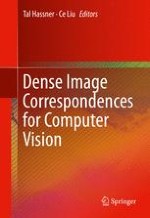2016 | OriginalPaper | Buchkapitel
In Defense of Gradient-Based Alignment on Densely Sampled Sparse Features
verfasst von : Hilton Bristow, Simon Lucey
Erschienen in: Dense Image Correspondences for Computer Vision
Aktivieren Sie unsere intelligente Suche, um passende Fachinhalte oder Patente zu finden.
Wählen Sie Textabschnitte aus um mit Künstlicher Intelligenz passenden Patente zu finden. powered by
Markieren Sie Textabschnitte, um KI-gestützt weitere passende Inhalte zu finden. powered by
